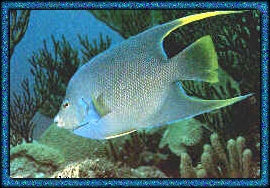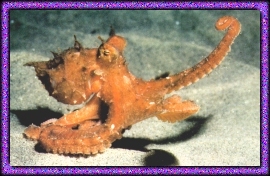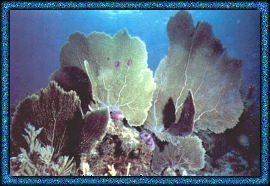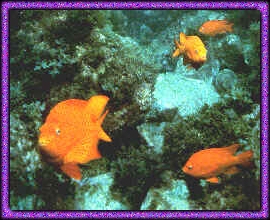 A first-time visitor to Earth, curious about the character of the planet, might logically choose to explore the ocean before considering the continents. The sea is easily Earth's most conspiciuous feature, and within its broad expanse and great depths lies the most complete record of life available. To dive in the ocean is to immerse yourself in living history - to see, touch, and know fragile beings whose ancestry spans hundreds of millions of years. Most are sustained by a solution of elements similar to the saline stream that courses through our veins, a reminder of the kinship we have with other life and with the ocean itself.
A first-time visitor to Earth, curious about the character of the planet, might logically choose to explore the ocean before considering the continents. The sea is easily Earth's most conspiciuous feature, and within its broad expanse and great depths lies the most complete record of life available. To dive in the ocean is to immerse yourself in living history - to see, touch, and know fragile beings whose ancestry spans hundreds of millions of years. Most are sustained by a solution of elements similar to the saline stream that courses through our veins, a reminder of the kinship we have with other life and with the ocean itself.
 It is possible to measure a century of change in the oceans by what was established by the British research vessel Challenger that embarked in 1872 on a scientific circumnavigation. Scientists aboard were the first to probe the ocean worldwide, to determine the breath and depth of the sea wilderness, to look for the special plants and anmals that live there, and to seek the dimensions and causes of currents, tides and temperature.
It is possible to measure a century of change in the oceans by what was established by the British research vessel Challenger that embarked in 1872 on a scientific circumnavigation. Scientists aboard were the first to probe the ocean worldwide, to determine the breath and depth of the sea wilderness, to look for the special plants and anmals that live there, and to seek the dimensions and causes of currents, tides and temperature.
 They determined long before echo-sounding and seismic techniques were devised for determining depth, soundings were made from the decks using the time-honored method of dangling a weight on a calibrated line. These soundings established rough contours for the ocean bottom and plumbed the deepest depth then known - 26,850 feet in the western Pacific ocean.
During their 3 1/2 years they collected tens of thousands of fishes and invertebrates. Their research proved that animal life is abundant in deep seas and they found species of relatively recent origin.
They determined long before echo-sounding and seismic techniques were devised for determining depth, soundings were made from the decks using the time-honored method of dangling a weight on a calibrated line. These soundings established rough contours for the ocean bottom and plumbed the deepest depth then known - 26,850 feet in the western Pacific ocean.
During their 3 1/2 years they collected tens of thousands of fishes and invertebrates. Their research proved that animal life is abundant in deep seas and they found species of relatively recent origin.
 Recent investigations have shown that the diversity of life in some communities at 14,000 feet is roughly equivalent to that in shallow tropical waters.
Recent investigations have shown that the diversity of life in some communities at 14,000 feet is roughly equivalent to that in shallow tropical waters.
There are towering mountains, deep trenches, underwater forests, valleys, plains, and desert landscapes as diverse as any of those found on dry land. There are as many varities of seascapes as landscapes. Shallow shores, coral reefs, open ocean, ocean depths, as well as polar seas. Each support a myriad of plant and animal life. Each play a vital role in sustaining the health of the seas - the health of planet Earth.




 A first-time visitor to Earth, curious about the character of the planet, might logically choose to explore the ocean before considering the continents. The sea is easily Earth's most conspiciuous feature, and within its broad expanse and great depths lies the most complete record of life available. To dive in the ocean is to immerse yourself in living history - to see, touch, and know fragile beings whose ancestry spans hundreds of millions of years. Most are sustained by a solution of elements similar to the saline stream that courses through our veins, a reminder of the kinship we have with other life and with the ocean itself.
A first-time visitor to Earth, curious about the character of the planet, might logically choose to explore the ocean before considering the continents. The sea is easily Earth's most conspiciuous feature, and within its broad expanse and great depths lies the most complete record of life available. To dive in the ocean is to immerse yourself in living history - to see, touch, and know fragile beings whose ancestry spans hundreds of millions of years. Most are sustained by a solution of elements similar to the saline stream that courses through our veins, a reminder of the kinship we have with other life and with the ocean itself. It is possible to measure a century of change in the oceans by what was established by the British research vessel Challenger that embarked in 1872 on a scientific circumnavigation. Scientists aboard were the first to probe the ocean worldwide, to determine the breath and depth of the sea wilderness, to look for the special plants and anmals that live there, and to seek the dimensions and causes of currents, tides and temperature.
It is possible to measure a century of change in the oceans by what was established by the British research vessel Challenger that embarked in 1872 on a scientific circumnavigation. Scientists aboard were the first to probe the ocean worldwide, to determine the breath and depth of the sea wilderness, to look for the special plants and anmals that live there, and to seek the dimensions and causes of currents, tides and temperature. They determined long before echo-sounding and seismic techniques were devised for determining depth, soundings were made from the decks using the time-honored method of dangling a weight on a calibrated line. These soundings established rough contours for the ocean bottom and plumbed the deepest depth then known - 26,850 feet in the western Pacific ocean.
During their 3 1/2 years they collected tens of thousands of fishes and invertebrates. Their research proved that animal life is abundant in deep seas and they found species of relatively recent origin.
They determined long before echo-sounding and seismic techniques were devised for determining depth, soundings were made from the decks using the time-honored method of dangling a weight on a calibrated line. These soundings established rough contours for the ocean bottom and plumbed the deepest depth then known - 26,850 feet in the western Pacific ocean.
During their 3 1/2 years they collected tens of thousands of fishes and invertebrates. Their research proved that animal life is abundant in deep seas and they found species of relatively recent origin. Recent investigations have shown that the diversity of life in some communities at 14,000 feet is roughly equivalent to that in shallow tropical waters.
Recent investigations have shown that the diversity of life in some communities at 14,000 feet is roughly equivalent to that in shallow tropical waters.